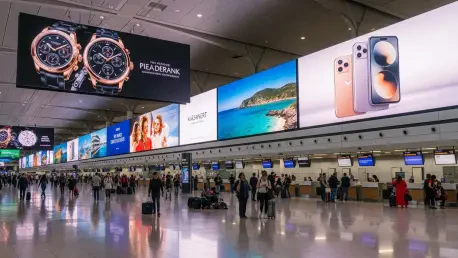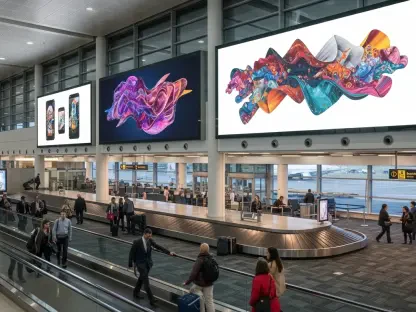Imagine stepping into a bustling subway station in the heart of a vibrant city like Hong Kong, where digital screens come alive with real-time content, inviting commuters to interact instantly with brands through lightning-fast connectivity. This is no longer a distant vision but a reality powered by 5G technology, transforming outdoor advertising into an immersive experience. The integration of 5G into high-traffic environments, such as Hong Kong’s MTR network, marks a pivotal shift in how advertisers engage with audiences, leveraging unprecedented speed and interactivity to redefine commuter experiences.
Key Features of 5G in Advertising
Harnessing the 5G Golden Spectrum
At the core of 5G’s impact on outdoor advertising lies the upgraded 5G Golden Spectrum, a technological backbone rolled out across nine major MTR stations in Hong Kong. This spectrum delivers ultra-fast internet speeds, enabling near-instantaneous content loading for passengers, whether they’re streaming videos or engaging with ads. Its ability to maintain robust network stability, even during peak commuting hours, ensures that connectivity remains uninterrupted, providing a seamless user experience.
Beyond speed, the ultra-low latency of this spectrum stands out as a critical advantage. It facilitates real-time interactions, such as live polls or gaming, directly on digital displays, making advertising more dynamic than ever. This reliability enhances the commuter journey by turning mundane waits into engaging moments, setting a new standard for urban advertising platforms.
Revolutionizing with Interactive Digital Displays
Another striking feature of 5G in advertising is the deployment of interactive digital displays at prominent MTR stations like Hong Kong, Causeway Bay, and Tsim Sha Tsui. These iconic screens serve as more than mere billboards; they act as portals for direct engagement, allowing passengers to interact with content in real time. From scanning QR codes to participating in live events, these displays create a two-way communication channel between brands and audiences.
The power of these screens lies in their ability to transform stations into entertainment hubs. Advertisers can update content on the fly, ensuring relevance and capturing attention with tailored messages. This adaptability not only boosts brand visibility but also fosters a deeper connection with commuters, turning passive viewers into active participants in the advertising narrative.
Performance in Real-World Campaigns
Spotlight on the 5G Summer Thrill Initiative
A landmark example of 5G’s application in outdoor advertising is a notable campaign rolled out across the MTR and Airport Express networks. Dubbed a summer-focused interactive promotion, this initiative harnessed live-streaming events to captivate commuters at key stations. By leveraging 5G’s capabilities, the campaign delivered real-time content that broke geographical barriers, connecting brands with audiences in a meaningful way.
The campaign’s use of high-definition digital screens showcased the potential of 5G to create impactful moments. Passengers could engage with live broadcasts or participate in interactive challenges, blending online and offline experiences seamlessly. This approach not only elevated the commuter experience but also amplified the effectiveness of advertising by ensuring content remained fresh and relevant.
Enhancing Brand Visibility through Connectivity
The real-world deployment of 5G in transit advertising has proven its ability to enhance brand visibility significantly. Advertisers now have the tools to interact directly with their target audience, overcoming traditional limitations of static displays. This immediacy allows for campaigns that adapt to current trends or events, maintaining a sense of urgency and relevance that resonates with urban dwellers.
Moreover, the integration of 5G supports a fusion of promotional strategies, bridging the gap between digital and physical realms. Brands can now craft campaigns that start with a digital interaction on a station screen and continue online, creating a cohesive narrative. This synergy has redefined how engagement is measured, focusing on depth rather than mere exposure.
Challenges in Scaling 5G Advertising
Technical and Implementation Hurdles
Despite its promise, the adoption of 5G in outdoor advertising faces notable technical challenges. Rolling out a high-capacity network across complex urban transit systems like the MTR requires significant infrastructure upgrades, often involving intricate coordination. Ensuring consistent coverage in underground or densely populated areas remains a persistent obstacle that demands innovative solutions.
Additionally, the cost of implementing such advanced technology can be prohibitive for widespread adoption. Smaller advertisers or less-funded transit systems may struggle to justify the investment, limiting the reach of 5G-driven campaigns. Addressing these barriers will require strategic partnerships and scalable models to democratize access to this cutting-edge tool.
Regulatory and Market Constraints
Beyond technical issues, regulatory constraints pose another layer of complexity for 5G advertising. Policies surrounding data privacy and digital content in public spaces vary widely, creating potential roadblocks for campaigns that rely on real-time interaction. Navigating these legal landscapes necessitates careful planning to ensure compliance without stifling creativity.
Market barriers also play a role, as not all regions are ready to embrace such advanced advertising formats. Resistance to change or lack of consumer familiarity with interactive technologies can dampen impact. Ongoing efforts to educate stakeholders and refine deployment strategies are crucial to overcoming these hurdles and expanding 5G’s footprint in advertising.
Future Trajectory of 5G in Urban Advertising
Innovations on the Horizon
Looking ahead, the potential for 5G in outdoor advertising appears boundless, with innovations poised to further enhance interactivity. Emerging technologies, such as augmented reality integrations on digital displays, could create even more immersive experiences for commuters. These advancements promise to blur the lines between advertisement and entertainment, captivating audiences in novel ways.
The expansion of 5G networks across global transit systems also holds exciting possibilities. As more cities adopt this technology, standardized platforms for advertising could emerge, enabling brands to launch synchronized campaigns worldwide. This scalability would amplify reach, making 5G a cornerstone of international marketing strategies.
Long-Term Impact on Brand-Consumer Dynamics
Over the long term, 5G is set to reshape how brands connect with consumers in dynamic urban settings. The focus will likely shift toward personalized, context-aware advertising that leverages real-time data to tailor messages. Such precision could redefine engagement metrics, prioritizing quality interactions over sheer volume.
Furthermore, as 5G infrastructure matures over the coming years, its integration with other smart city technologies could create holistic ecosystems. Advertisers might tap into broader networks of connected devices, from smart billboards to wearable tech, crafting seamless consumer journeys. This evolution points to a future where advertising becomes an integral part of urban life, driven by connectivity and innovation.
Final Reflections on 5G’s Role in Advertising
Reflecting on the journey of 5G in outdoor advertising, it is clear that initiatives like the summer interactive campaign within Hong Kong’s MTR network marked a transformative moment. The technology demonstrated remarkable potential in enhancing commuter engagement and redefining brand visibility through real-time, dynamic content. Its performance in high-traffic environments underscored a shift toward more immediate and impactful advertising methods.
Moving forward, stakeholders should prioritize addressing technical and regulatory challenges by fostering collaborations between tech providers, transit authorities, and advertisers. Investing in pilot programs to test scalability in diverse markets could pave the way for broader adoption. Additionally, educating both brands and consumers about the benefits of interactive 5G platforms will be key to sustaining momentum and unlocking the full potential of this revolutionary technology in urban advertising landscapes.









